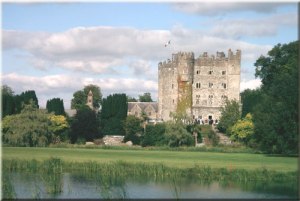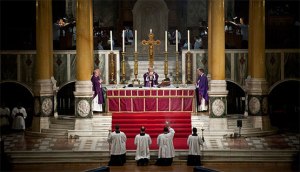Frederick (1857 -1924) and Walter Fitzgerald (1858 – 1923) were younger sons of the 4th Duke of Leinster. They were the eighth, and ninth, children respectively, and the third , and fourth sons. Both seemed to have lived mostly ay Kilkea Castle which was one of the family homes, but not at Carton House, in co. Kildare, which was the family seat in the nineteenth century, until its sale in 1920’s to pay the gambling debts of the 7th Duke. Lord Walter Fitzgerald was an antiquarian, and Irish historian.
The Kildare Observer 24 October 1898
The Leinster Family – Lords Walter & Frederick Fitzgerald
References to the old family of the Fitzgeralds were made recently in the “Daily Independent.” Writing with regard to Lords Walter and Frederick, the “Independent” says: –

“Lord Walter Fitzgerald resides at Kilkea Castle, Co. Kildare, a charming old residence which has been for centuries one of the family places of the Earls of Kildare. Now that the tradition of 1798 have been revived, sombre interest is attached to the place, by reason of the fact that Lord Edward Fitzgerald interested himself to procure a lease of the Castle and lands from his brother, the Duke of Leinster, for his friend, Thomas Reynolds, one of the Leinster Council of the United Irishmen. But Reynolds lived, never suspected of the deepest treachery which ever disgraced the name of Irishman. This Reynolds it was who gave information to the Government, which resulted in the arrest in Bond’s house of the Revolutionary Directorate just a few days before the appointed date of the Insurrection. He bargained his price and he was paid it. In Kilkea are some valuable family paintings, and perhaps, the best portrait by Hamilton, of the ill-fated Lord Edward hangs upon the walls of the Library.
Lord Walter takes a keen interest in the life and times of Lord Edward, for he is a thorough Irishman, and delights to dwell upon the glorious traditions of the House of Geraldine. He is a well known archaeologist and is an authority upon Celtic nomenclature. When the editor of the “Weekly Independent” was compiling material for his article for the Christmas Number of that newspaper, Lord Walter gave him much valuable information and, unhesitatingly placed at his disposal many documents which were of rare value and historical worth. Perhaps the most significant, certainly the most pathetic treasure in Kilkea, is the plastic cast from the inscription cut in the wall of the cell in the Tower of London, by “Silken Thomas” over four hundred years ago. It reads: “Thomas Fitzger.” The Lord of O’Fally was dragged to the headsman before his hand had finished the inscription. It was at Kilkea that the Wizard Earl of Kildare practised the black arts; and there is a story accredited to present day, that on breaking down a wall in the place long ago, a secret chamber was discovered, wherein sat the figure of a grey haired man poring over a parchment covered with strange characters. With the rush of air the form crumbled away, and nothing remained but a handful of dust.
Beneath the shadow of Kilkea Castle is an old burying ground, moss and lichen overspreading many a forgotten slab and grave. There is humour in all things, and Lord Walter Fitzgerald will not let you depart until you take a look at one headstone which is a perpetual joke. It reads: –
Erected by
THOMAS O’TOOLE.
1779,
In memory of his posterity.
A Scottish antiquarian strayed down to Kilkea once upon a time, and the humour of this penetrated into his brain, and in the excess of his astonishment he offered to purchase the tombstone. Needless to say, he left without even taking away even a rubbing of the grim piece of humour that laughs on one hundred years after the good-hearted Thomas O’Toole was laid to rest. Lord Walter has, since the publication of “The Geraldine,” been pleased to express himself extremely gratified at the way Lord Edward’s life has been treated by the Editor of the “Weekly Independent.”
Lord Frederick Fitzgerald, the late Duke of Leinster’s eldest brother, is the guardian of the present young duke, whose charming personality has been noticed in this column. Lord Frederick, like his brother Lord Walter Fitzgerald, was pleased beyond measure when he heard that the story of Lord Edward Fitzgerald was to be made the subject of the Christmas number of the “Weekly Independent.” Like most others, he recognised that no brief and continuous narrative of Lord Edward was in existence, and he did his share in helping the editor of our contemporary in making his sketch authentic and complete. He placed the documents he had in the Carton [ Carton House, co. Kildare was the main family seat from 1815 until the 1920’s.] collection at the disposal of the editor of the “Weekly Independent,” and permitted Mr. W.C. Mills to make sketches of any historical articles or pictures which might be of interest. Of these latter, the pike presented by the United Irishmen to Lord Edward takes first rank.

Lord Frederick Fitzgerald held a position in the Rifles, and saw a considerable amount of active service. Perhaps the most interesting part of his military career was when his battalion was on eviction duty in the North of Ireland. The peasants invariably drew a hard and fast line between the military and police, and whereas the R.I.C came in for all the contumely, the Rifles were “Never bothered at all, at all.” One day an old peasant, who had been reading in the “Derry Journal” that the men who resisted extermination following in the footsteps of Tone and Lord Edward Fitzgerald, came up to Lord Frederick as he stood in front of his company and asked “Tell me yer honour, aren’t you a relative of Lord Edward?” “I am” answered the Major of the Rifles. “An’ why are ye here,” asked the peasant, “an’ Lord Edward such a friend of Mr Parnell’s?” Lord Frederick was dumbfounded, but managed to reply “Well, you see, Lord Edward is dead for nearly hundred years.” “Divil may care,” replied the hardy peasant; “if he was alive wouldn’t he be on Parnell’s side?” “To tell you the truth” answered the officer, “I believe he would be.” That night the healths of Mr Parnell, Lord Edward, and the commander of the Rifle detachment were drunk in three times three in the house by the cross-roads.












